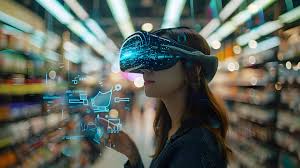Immersive Marketing: The Rise of AR and VR in Enhancing Customer Experiences

Strong 8k brings an ultra-HD IPTV experience to your living room and your pocket.
Technology is redefining how brands interact with customers, and immersive marketing is leading this transformation. With augmented reality (AR) and virtual reality (VR), businesses are delivering experiences that engage customers in ways unimaginable a decade ago. In India, the adoption of AR and VR in marketing is gaining momentum, driven by increased smartphone usage, 5G rollout, and the push for digital innovation.
By 2025, the AR and VR market in India is projected to reach ₹85,000 crores, growing at an annual rate of 38%. These technologies are not just tools for gaming or entertainment—they’re becoming integral to customer experiences across sectors like retail, real estate, and healthcare.
The Appeal of Immersive Marketing
Personalized and Interactive Experiences
Unlike traditional advertising, AR and VR allow users to actively participate. Customers no longer just view products—they try them virtually, explore how they fit their needs, and make confident decisions.
For example, Lenskart uses AR to let customers try on glasses virtually, right from their homes in cities like Bengaluru or even smaller towns like Kanpur. This feature saw their online sales increase by 25% within a year.
Stronger Emotional Connections
Immersive marketing creates memorable experiences. A VR walk-through of a property or an AR filter showcasing how furniture fits in your living room triggers an emotional connection that static images or videos can’t match.
Trends for 2025: AR and VR Revolution
1. Retail Goes Immersive
By 2025, over 40% of Indian online shoppers are expected to interact with AR before making a purchase. Brands like Nykaa are already using AR to help customers test makeup shades virtually, saving time and reducing returns.
The surge in e-commerce platforms offering AR tools is inevitable as customer preferences for try-before-you-buy options grow.
2. Virtual Stores and Showrooms
With VR, customers can explore virtual stores from their homes. Tata Motors has piloted VR showrooms in cities like Mumbai, where buyers can check car interiors and exteriors without stepping into a physical dealership.
This trend is expected to expand, with experts predicting a 50% increase in VR-powered sales tools for the automotive industry in India by 2025.
3. Enhanced Travel and Hospitality
Travel brands are leveraging VR to showcase destinations. A Kerala tourism company used VR tours to highlight their backwater experiences and saw a 15% rise in inquiries during 2024. This approach is set to grow as Indian travelers increasingly use VR to preview trips.
4. Education and Training
AR and VR are also reshaping learning experiences. By 2025, AR and VR-based training modules for retail employees are projected to increase efficiency by 30%, as reported by an SEO company studying consumer behavior trends in India.
Overcoming Challenges
Cost of Technology
While AR and VR offer exciting possibilities, the upfront investment can be significant. However, with increasing competition among tech providers, the cost of these tools is expected to decrease by 15–20% by 2025.
Digital Divide
In India, access to immersive experiences is still limited in rural areas. However, as affordable 5G networks expand to states like Bihar and Odisha, more customers will be able to participate in AR and VR experiences.
How Businesses Can Succeed
1. Partner with Digital Experts
Collaborate with a digital marketing company or a social media agency that specializes in immersive technologies. They can help craft engaging AR filters or design VR experiences tailored to your audience.
2. Focus on Mobile Optimization
With over 750 million smartphone users in India, mobile-friendly AR and VR experiences are crucial. Ensure your applications run smoothly on devices used in both urban centers like Delhi and rural areas.
3. Measure Success with Analytics
Immersive marketing offers a wealth of data. Track engagement metrics like the time spent using AR features or VR session completion rates. These insights can guide improvements and increase ROI.
The Economic Impact
By 2025, immersive marketing is expected to contribute ₹30,000 crores to India’s retail sector alone. Real estate, another early adopter, is estimated to generate ₹12,000 crores through AR and VR-based property tours. These numbers demonstrate the growing influence of AR and VR in driving business growth.
Real-World Success Stories
L’Oreal India
Using AR-powered apps, customers could try on virtual makeup before buying. This feature led to a 20% jump in conversion rates during 2024, and with 5G, usage is expected to double in 2025.
Reliance Trends
Reliance Trends introduced VR-powered fashion shows accessible via their app. Customers could view new collections and purchase directly, leading to a 15% increase in sales.
A Vision for the Future
The rise of AR and VR is not just a trend—it’s a fundamental shift in how brands connect with their audiences. From enhancing product discovery to building stronger customer loyalty, these technologies are set to redefine marketing in India.
For businesses looking to stay ahead, now is the time to explore immersive marketing. With AR and VR driving customer satisfaction and sales, investing in these tools is no longer optional—it’s essential for long-term success.
Note: IndiBlogHub features both user-submitted and editorial content. We do not verify third-party contributions. Read our Disclaimer and Privacy Policyfor details.




